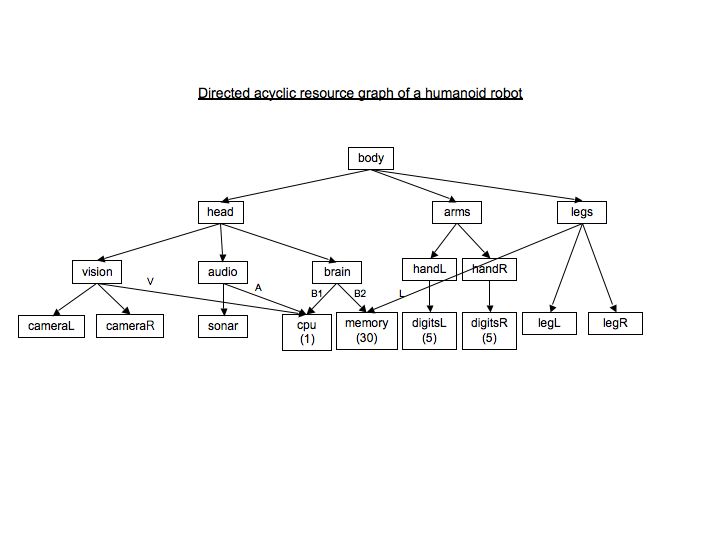Hierarchial Resources¶
10 Jan 2023
In applications where a large number of command resources are used, and some of the resources are interdependent, it might be cumbersome to specify each resource element in the plan individually.
The PLEXIL resource file format allows interdependence between resources to be specified as a weighted directed acyclic graph. When a particular resource requirement is referenced in the plan, all the descendants of that resource also get pulled in; the descendants’ requests are automatically scaled by the specified weights.
Consider the resource hierarchy in this diagram:

The relationships in the diagram are reflected in an example resource data file, in plexil/examples/resources/resource3.data, whose contents are:
%Contains the resource hierarchy
% name initial-resource [child-weight child-name]*
body 1.0 1.0 head 1.0 arms 1.0 legs
head 1.0 1.0 vision 1.0 audio 1.0 brain
vision 1.0 1.0 cameraL 1.0 cameraR 0.3 cpu
audio 1.0 1.0 sonar 0.2 cpu
brain 1.0 0.5 cpu 0.4 memory
arms 1.0 1.0 handL 1.0 handR
handL 1.0 1.0 digitsL
handR 1.0 1.0 digitsR
legs 1.0 1.0 legL 1.0 legR 0.3 memory
digitsL 5.0
digitsR 5.0
legL 1.0
legR 1.0
cameraL 1.0
cameraR 1.0
sonar 1.0
cpu 1.0
memory 1.0
sys_memory 1.0
Now consider the plan below (found in plexil/examples/resources/resource3.ple) in the context of this resource file
Integer Command c1;
Integer Command c2;
Integer Command c3;
SimpleTask:
Concurrence {
C1: {
Integer returnValue = -1;
EndCondition returnValue == 10;
PostCondition C1.command_handle == COMMAND_SUCCESS;
Resource Name = "head", Priority = 20;
returnValue = c1();
}
C2: {
Integer returnValue = -1;
RepeatCondition C2.command_handle == COMMAND_DENIED;
PostCondition C2.command_handle == COMMAND_SUCCESS;
EndCondition returnValue == 10;
Resource Name = "memory",
UpperBound = 0.3,
Priority = 25;
returnValue = c2();
}
C3: {
Integer returnValue = -1;
PostCondition C3.command_handle == COMMAND_SUCCESS;
EndCondition returnValue == 10;
Resource Name = "vision", Priority = 30;
returnValue = c3();
}
}
The plan consists of three Command nodes executing concurrently:
C1, C2, and C3. Node C1 requires the head resource
with priority 20, node C3 requires the vision resource with
priority 30, and node C2 requires 0.3 units of the memory
resource with priority 25.
Let’s look at each of these commands’ respective requirements in the context of the above resource structure and the commands’ priorities.
Node C1 requires 1.0 units of the head resource, which in turn
requires 1.0 units each of dependent resources vision, audio,
and brain. At the next level, each unit of vision requires 1.0
units each of cameraL and cameraR, and V units of cpu. In
the resource data file above, V = 0.3. Next, each unit of audio
requires 1.0 units of sonar and A units of cpu. Here A =
0.2. Finishing out the indirect dependencies, each unit of brain
requires B1 units of cpu and B2 units of memory. In the
resource data above, B1 = 0.5 and B2 = 0.4.
So the total resource requirements of node C1 are: head: 1.0;
vision: 1.0; audio: 1.0; brain: 1.0; cameraL: 1.0;
cameraR: 1.0; sonar: 1.0; cpu: 0.3 + 0.2 + 0.4 = 0.9;
memory: 0.4.
Following the same chain of reasoning, node C2 directly requires
memory: 0.3.
Node C3 requires: vision: 1.0, cameraL: 1.0; cameraR:
1.0; cpu: 0.3.
Of the 3 nodes, C1 has the best priority, 20. Therefore its
requirements are processed before those of C2 and C3. As all
of its requirements can be satisfied from the available resources,
C1 is allowed to execute. This results in all of head,
vision, audio, brain, cameraL, cameraR, and
sonar, 0.9 units of cpu, and 0.4 units of memory getting
allocated to C1. 0.1 units of cpu and 29.6 units of memory
remain available.
Next in priority order, at priority 25, C2 requires 0.3 units of
memory. With 29.6 units remaining, this request can be satisfied,
so the arbiter grants the allocation of memory to C2, and
allows it to execute. This leaves 29.3 units of memory available.
Last, at priority 30, several resources required by C3 have
already been completely allocated to C1; these are vision,
cameraL, and cameraR. Therefore permission to execute C3
is denied by the arbiter.